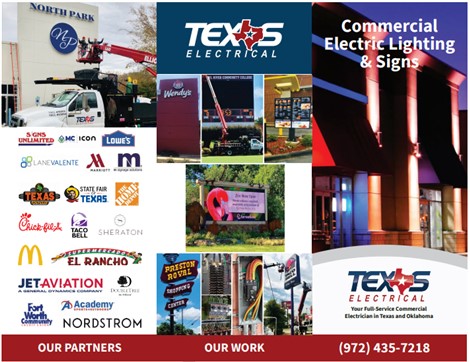
Texas Electrical has been acquired by DFW Longhorn Electric - Learn More!

Texas Electrical has been acquired by DFW Longhorn Electric - Learn More!
Lighting FAQ
There are several reasons why LED lights might flicker. Here are some of the most common causes:
If you are experiencing flickering LED lights, it is important to first identify the cause of the problem. Once you have identified the cause, you can take steps to fix it. For example, if the problem is caused by an incompatible dimmer switch, you can replace the dimmer switch with one that is compatible with LED lights.
Here are some tips to help you troubleshoot flickering LED lights:
The most efficient commercial lighting is LED lighting. LEDs use up to 90% less energy than traditional incandescent bulbs and last up to 25 times longer. They also produce a more natural light that is better for people's health and productivity.
Here are some of the benefits of using LED lighting in commercial buildings:
If you're looking for the most efficient commercial lighting, LED is the clear choice. They offer significant energy savings, a longer lifespan, and better light quality.
Here are some specific examples of LED commercial lighting fixtures:
When choosing LED commercial lighting fixtures, it is important to consider the following factors:
If you are considering upgrading to LED commercial lighting, there are a few things you can do to get started:
Upgrading to LED commercial lighting is a great way to save energy, reduce your carbon footprint, and improve the quality of light in your space. With so many benefits, it is no wonder that LED lighting is quickly becoming the standard for commercial lighting.
Electrical FAQ's
The main difference between commercial and industrial electrical is the type of work environment. Commercial electricians typically work in commercial buildings, like retail stores and restaurants, ensuring that the wiring and electrical components are operating safely and efficiently. Industrial electricians, on the other hand, normally work in manufacturing plants and production facilities with complex, sensitive, and expensive machinery and electrical systems. Industrial electricians maintain a more extensive range of electrical systems, from micro-currents to high-voltage components.
Here is a table that summarizes the key differences between commercial and industrial electrical:

Here are some additional points of difference between commercial and industrial electrical:
If you are interested in a career in electrical work, it is important to consider the type of work environment that you prefer. If you are looking for a job that involves working with a variety of electrical systems in a safe and secure environment, then industrial electrical may be a good fit for you. If you are looking for a job that involves working with basic electrical systems in a less demanding environment, then commercial electrical may be a good fit for you.
A commercial electrician is a trained and licensed electrician who specializes in the installation, maintenance, and repair of electrical systems in commercial buildings. This includes everything from small businesses to large office buildings, schools, hospitals, and other public spaces.
Commercial electricians typically work with larger and more complex electrical systems than residential electricians. They may also need to work with specialized equipment and materials, such as generators, transformers, and high-voltage cables
In addition to their technical skills, commercial electricians also need to have strong communication and problem-solving skills. They often need to work with architects, engineers, and other contractors to ensure that electrical systems are installed and maintained correctly.
Here are some of the key differences between commercial electricians and residential electricians:
State of Texas
Regulated by The Texas Department of Licensing and Regulation, P.O. Box 12157, Austin, Texas 78711, 1-800-803-9202, 512-463-6599;
website: www.tdlr.texas.gov, TDLR EC#33894 DLR ESC#18955, Electrical Contractor License #165179, Electrical Sign Contractor License #275461


At Texas Electrical, it’s not enough for us to simply satisfy our customers, we want to completely exceed every expectation.